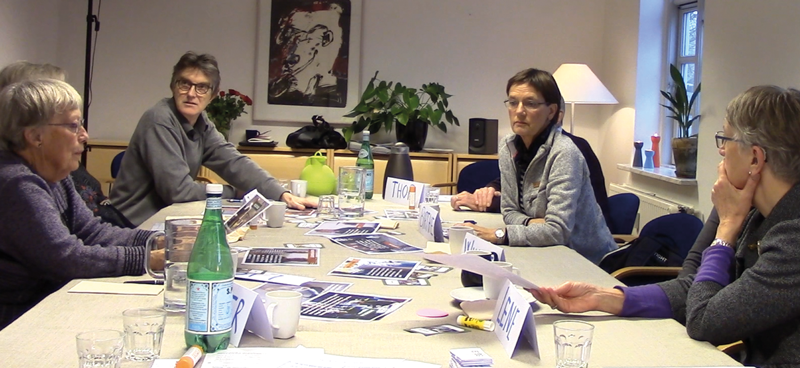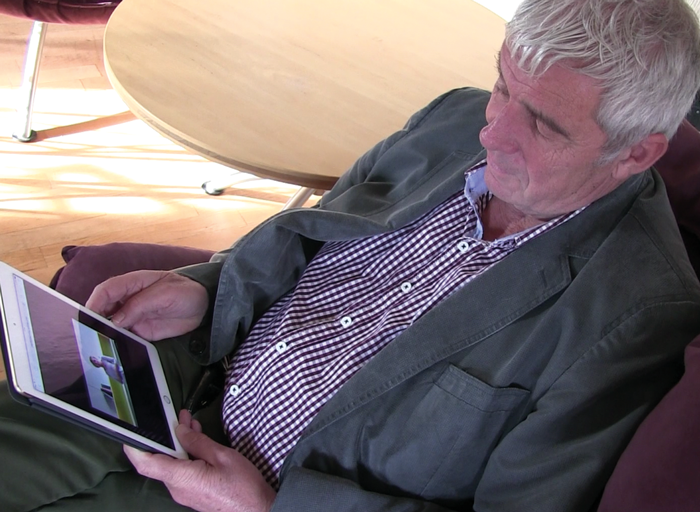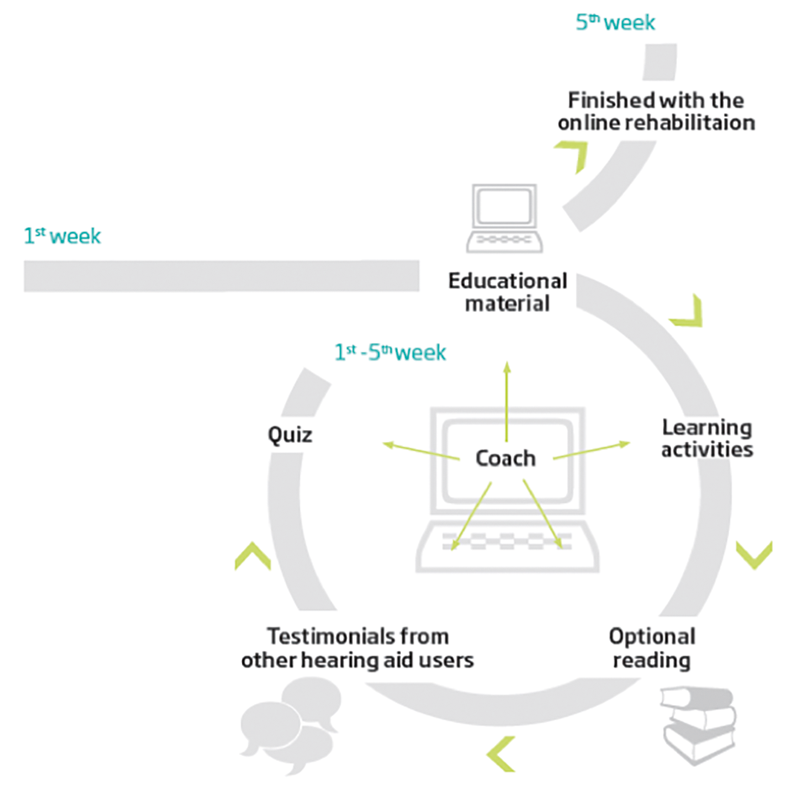Recent research shows that online audiological rehabilitation programmes have the potential to improve the quality of life of hearing aid users. However, there are still areas that need need improvement. Elisabet Thorén discusses some of the problems people face when using these online rehabilitative tools and the ways in which these issues are being addressed.
Results from previous studies on audiological online rehabilitation indicate that the internet can be used to deliver education and rehabilitation to experienced hearing aid users who report residual hearing problems. However, the outcomes of the studies also indicate that content and format of the online audiological rehabilitation programme requires further investigation. There is a need to collect the users’ perspectives of content and user interface in the process of developing online audiological rehabilitation programmes.
There is a significant increase of studies showing that online tools are useful in the audiological rehabilitation process. Some studies show positive effects of using digital media as an online support to the delivery of audiologic rehabilitation [1]. Some studies show that using instructional video clips are a cost-effective way of improving rehabilitation [2] while other studies show improvement of subjectively reported hearing difficulties when using online audiological rehabilitation programmes with experienced hearing aid users [3,4].
“The early findings of feedback from hearing aid users emphasise the importance of how the content is delivered.”
However, the outcomes of the studies also indicate that content and format of online rehabilitation programmes require further investigation. Although some research has used patient groups to develop the content of an intervention [2], it’s important to keep in mind the importance of improving the user’s benefit of such programmes related to the user’s perspective of how to develop online audiological rehabilitation programmes.

Experienced hearing aid users participating in focus group interview.
A way to improve user satisfaction and benefit of a given tool, such as an online audiological rehabilitation programme, is to involve the participators, i.e. hearing aid users, as early as possible in the development process [2,5]. Thereby, it is more likely that the users will use the product to their satisfaction.
Built on previous research, studies and experiences, a new digital platform has been chosen to further improve the user experience when developing a new version of an online audiological rehabilitation programme [6]. Hearing aid users in the age range of 60-77 years have been involved in the development process at two phases; before designing the content and delivery of the rehabilitation programme and further on, to get feedback of user interface and software use.
In the first phase of the development process, experienced hearing aid users participated in a focus group. The methodology of the focus group included use of probes: thereby the discussions were led in such a as to establish the direction to establish the participants’ use of computers, their goals with audiological rehabilitation, challenging hearing situations and learning preferences.

Experienced hearing aid user evaluating usability of online audiological rehabilitation programme.
The result of the focus group showed that the participants were well aware of their hearing loss, which situations were particularly challenging, and also that their hearing problems are likely to get worse. The participants expressed an uncertainty of how to communicate about their hearing problems to spouses. They also varied greatly in computer use and computer experiences. The discussions in the focus group concentrated on how to improve hearing in difficult hearing situations, such as social gatherings, and get help with planning participation, instead of withdrawing from such activities. The outcome also showed that the participants felt that they were no longer spontaneous, they had identified changing roles within the family, and the benefit from hearing aids was high, but not always enough.
The motivation for using online audiological rehabilitation was identified as a need for improving hearing knowledge, but also to receive professional counselling and insights. Further on, the users agreed that any online tool needs to be flexible and easy to use, needs to include visual explanations, and should be updated with the latest information. Also, some kind of interaction with a hearing care professional was appreciated.
The outcome of the focus group included participants’ goals with online audiological rehabilitation. The goals described included getting more practical experiences with hearing aids to improve optimal use, developing skills of hearing tactics and strategies, and learning how to communicate hearing loss to family members, spouses and working colleagues.
In the second phase of the development process, participants’ feedback was collected on early revisions of a new edition of an online audiological rehabilitation programme. The ‘think aloud’ method was used and the participants gave feedback in a structured manner as well as spontaneous and unstructured feedback, which was collected with a video camera during the visits [7].
“The participants found the programme an attractive solution to completing rehabilitation at home and they were excited about learning new things.“
In the early revision the participants commented on difficulties using the programme, having found it demanding to create an account and log on go back and forth, and complete the course. A second revision of the programme was more appreciated with a simple instructional design, little interruptions in the user interface and easier navigation. However, the users still had difficulty creating an account and logging on to the programme. The participants found the programme an attractive solution to completing rehabilitation at home and they were excited about learning new things, including maximising the effectiveness of their hearing aids.
The early findings of feedback from hearing aid users emphasise the importance of how the content is delivered [6]. When developing online tools for hearing aid users, it is important to establish an effective learning flow and simple navigation, and to ensure that the learning activities are engaging. Finally, it was discovered that a tablet was preferred over a computer by the participants due to its simplicity of use and ease of adjustment for varying visual capabilities.
The outcome of the participants’ involvement in phase one and two of the development process is a suggested online audiological rehabilitation programme consisting of weekly learning modules. Each module will have a specific topic related to hearing, an introduction to hearing aids, communication strategies and information on how to communicate hearing loss. Each module will be structured in the same fashion and include informational material in the form of video, text and interaction tasks (see Figure 1).

Figure 1: Overview of the flow of the learning elements included in
the proposed internet-based rehabilitation programme.
The development of online rehabilitation programmes may foster behavioural changes that will have a positive effect on the quality of life of people who are using hearing aids. When using online tools and internet-supported rehabilitation in a cost-effective way, more people can access comprehensive rehabilitation programmes that go well beyond the basic fitting of hearing aids.
Early findings from hearing aid users evaluating the online audiological programme and development provide useful information about what content to deliver and how content can be developed and delivered for optimal dissemination within the scope of an online audiological rehabilitation programme.
References
1. Brännström KJ, Öberg M, Ingo E, Månsson KM, et al. The initial evaluation of an Internet-based support system for audiologists and first-time hearing aid clients. American Journal of Audiology 2016;82-91.
2. Ferguson M, Brandreth M, Brassington W, et al. A randomized controlled trial to evaluate the benefits of a multimedia educational program for first-time hearing aid users. Ear Hear 2016;37:123-36.
3. Thorén ES, Öberg M, Wänström G, et al. A randomized controlled trial evaluating the effects of online rehabilitative intervention for adult hearing-aid users. International Journal of Audiology 2014;53:452-61.
4. Thorén E, Svensson M, Törnqvist A, et al. Rehabilitative Online Education versus Internet Discussion Group for Hearing Aid Users: A Randomized Controlled Trial. J Am Acad Audiol 2011;22:274-85.
5. Shah S, Robinson I. Benefits of and barriers to involving users in medical device technology development and evaluation. International Journal of Technology Assessment in Health Care 2007;23:131-7.
6. Thorén ES, Pedersen JH, Jornaes NO. Usability and Online Audiological Rehabilitation. American Journal of Audiology 2016;25:284-7.
7. Tsakonas G, Papatheodorou C. Analysing and evaluating usefulness and usability in electronic information services. Journal of Information Science 2006;32:400-19.
Declaration of competing interests: Elisabet Thorén is employed by the Danish hearing aid manufacturer, Oticon A/S.
Dr Elisabet S Thorén manages eHealth projects at Eriksholm Research Centre. Dr Thorén received her MSc in medical science from Lund University Sweden, major in audiology and she is a certified audiologist. In 2014 she obtained her PhD in medical science from Linköping University, Sweden. Dr Thorén’s research area includes tele-audiology, the relationships between cognitive abilities and hearing loss, as well as the rehabilitation process of adult people with hearing loss.




